CADILLAC STS 2008 1.G Owners Manual
Manufacturer: CADILLAC, Model Year: 2008, Model line: STS, Model: CADILLAC STS 2008 1.GPages: 500, PDF Size: 5.81 MB
Page 201 of 500
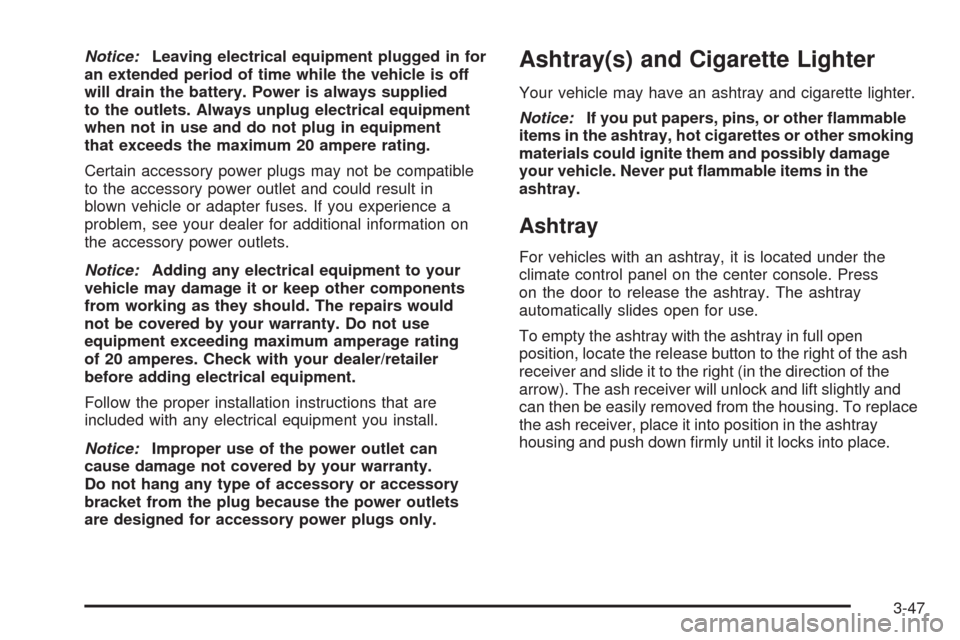
Notice:Leaving electrical equipment plugged in for
an extended period of time while the vehicle is off
will drain the battery. Power is always supplied
to the outlets. Always unplug electrical equipment
when not in use and do not plug in equipment
that exceeds the maximum 20 ampere rating.
Certain accessory power plugs may not be compatible
to the accessory power outlet and could result in
blown vehicle or adapter fuses. If you experience a
problem, see your dealer for additional information on
the accessory power outlets.
Notice:Adding any electrical equipment to your
vehicle may damage it or keep other components
from working as they should. The repairs would
not be covered by your warranty. Do not use
equipment exceeding maximum amperage rating
of 20 amperes. Check with your dealer/retailer
before adding electrical equipment.
Follow the proper installation instructions that are
included with any electrical equipment you install.
Notice:Improper use of the power outlet can
cause damage not covered by your warranty.
Do not hang any type of accessory or accessory
bracket from the plug because the power outlets
are designed for accessory power plugs only.Ashtray(s) and Cigarette Lighter
Your vehicle may have an ashtray and cigarette lighter.
Notice:If you put papers, pins, or other �ammable
items in the ashtray, hot cigarettes or other smoking
materials could ignite them and possibly damage
your vehicle. Never put �ammable items in the
ashtray.
Ashtray
For vehicles with an ashtray, it is located under the
climate control panel on the center console. Press
on the door to release the ashtray. The ashtray
automatically slides open for use.
To empty the ashtray with the ashtray in full open
position, locate the release button to the right of the ash
receiver and slide it to the right (in the direction of the
arrow). The ash receiver will unlock and lift slightly and
can then be easily removed from the housing. To replace
the ash receiver, place it into position in the ashtray
housing and push down �rmly until it locks into place.
3-47
Page 202 of 500
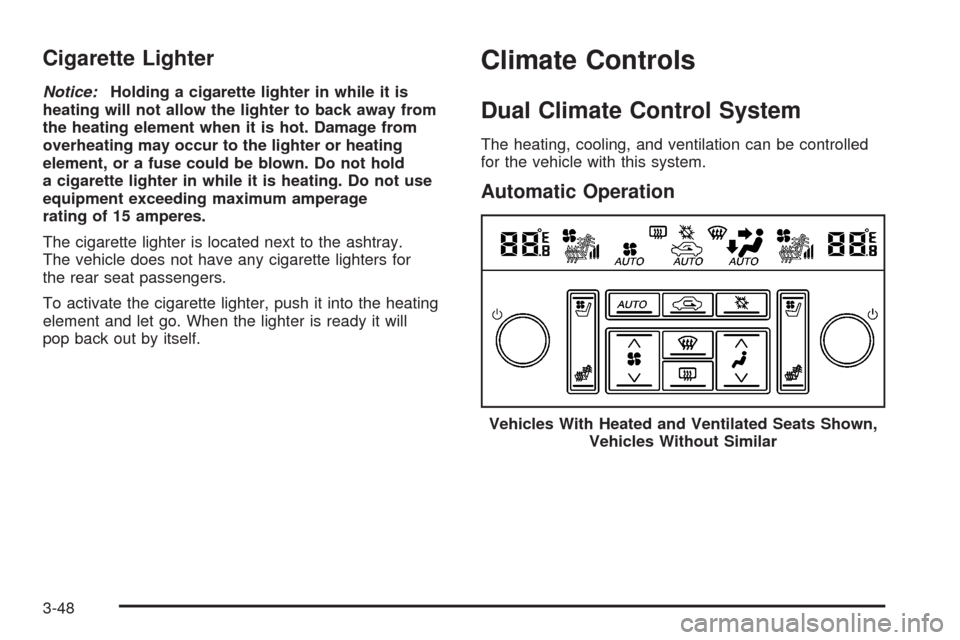
Cigarette Lighter
Notice:Holding a cigarette lighter in while it is
heating will not allow the lighter to back away from
the heating element when it is hot. Damage from
overheating may occur to the lighter or heating
element, or a fuse could be blown. Do not hold
a cigarette lighter in while it is heating. Do not use
equipment exceeding maximum amperage
rating of 15 amperes.
The cigarette lighter is located next to the ashtray.
The vehicle does not have any cigarette lighters for
the rear seat passengers.
To activate the cigarette lighter, push it into the heating
element and let go. When the lighter is ready it will
pop back out by itself.
Climate Controls
Dual Climate Control System
The heating, cooling, and ventilation can be controlled
for the vehicle with this system.
Automatic Operation
Vehicles With Heated and Ventilated Seats Shown,
Vehicles Without Similar
3-48
Page 203 of 500
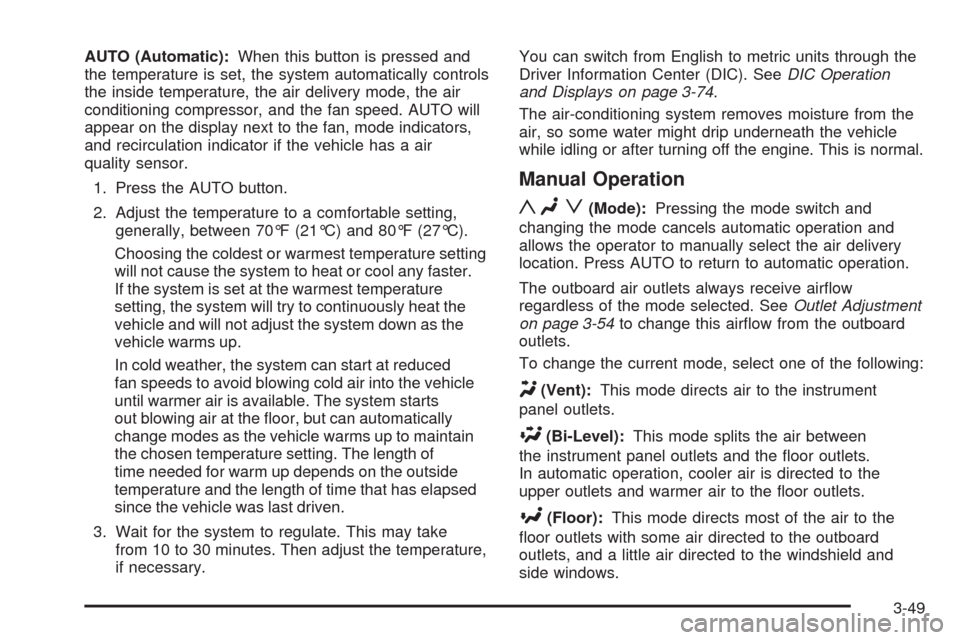
AUTO (Automatic):When this button is pressed and
the temperature is set, the system automatically controls
the inside temperature, the air delivery mode, the air
conditioning compressor, and the fan speed. AUTO will
appear on the display next to the fan, mode indicators,
and recirculation indicator if the vehicle has a air
quality sensor.
1. Press the AUTO button.
2. Adjust the temperature to a comfortable setting,
generally, between 70°F (21°C) and 80°F (27°C).
Choosing the coldest or warmest temperature setting
will not cause the system to heat or cool any faster.
If the system is set at the warmest temperature
setting, the system will try to continuously heat the
vehicle and will not adjust the system down as the
vehicle warms up.
In cold weather, the system can start at reduced
fan speeds to avoid blowing cold air into the vehicle
until warmer air is available. The system starts
out blowing air at the �oor, but can automatically
change modes as the vehicle warms up to maintain
the chosen temperature setting. The length of
time needed for warm up depends on the outside
temperature and the length of time that has elapsed
since the vehicle was last driven.
3. Wait for the system to regulate. This may take
from 10 to 30 minutes. Then adjust the temperature,
if necessary.You can switch from English to metric units through the
Driver Information Center (DIC). SeeDIC Operation
and Displays on page 3-74.
The air-conditioning system removes moisture from the
air, so some water might drip underneath the vehicle
while idling or after turning off the engine. This is normal.
Manual Operation
yNz(Mode):Pressing the mode switch and
changing the mode cancels automatic operation and
allows the operator to manually select the air delivery
location. Press AUTO to return to automatic operation.
The outboard air outlets always receive air�ow
regardless of the mode selected. SeeOutlet Adjustment
on page 3-54to change this air�ow from the outboard
outlets.
To change the current mode, select one of the following:
Y(Vent):This mode directs air to the instrument
panel outlets.
\(Bi-Level):This mode splits the air between
the instrument panel outlets and the �oor outlets.
In automatic operation, cooler air is directed to the
upper outlets and warmer air to the �oor outlets.
[(Floor):This mode directs most of the air to the
�oor outlets with some air directed to the outboard
outlets, and a little air directed to the windshield and
side windows.
3-49
Page 204 of 500
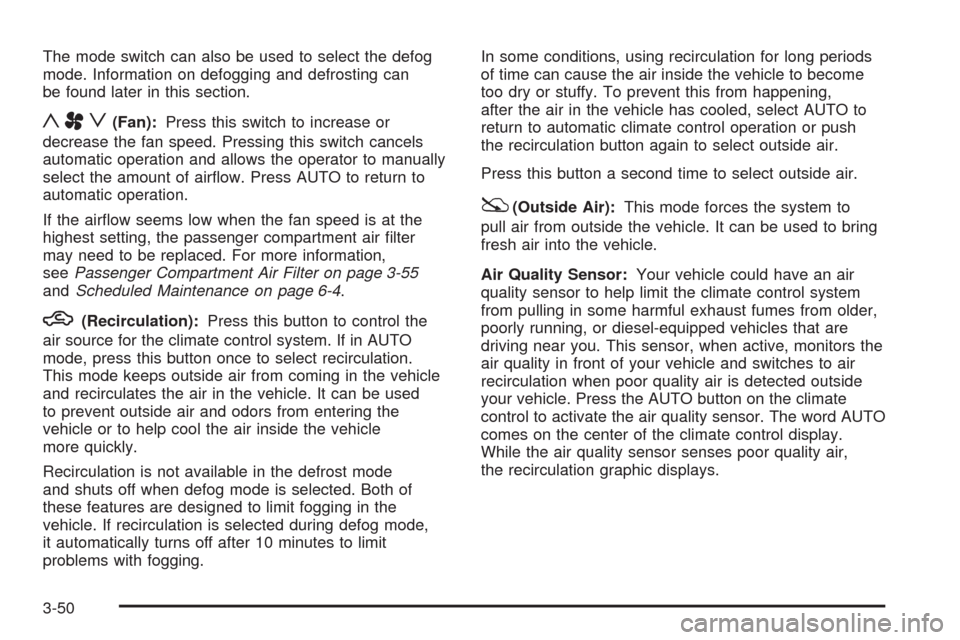
The mode switch can also be used to select the defog
mode. Information on defogging and defrosting can
be found later in this section.
yAz(Fan):Press this switch to increase or
decrease the fan speed. Pressing this switch cancels
automatic operation and allows the operator to manually
select the amount of air�ow. Press AUTO to return to
automatic operation.
If the air�ow seems low when the fan speed is at the
highest setting, the passenger compartment air �lter
may need to be replaced. For more information,
seePassenger Compartment Air Filter on page 3-55
andScheduled Maintenance on page 6-4.
h(Recirculation):Press this button to control the
air source for the climate control system. If in AUTO
mode, press this button once to select recirculation.
This mode keeps outside air from coming in the vehicle
and recirculates the air in the vehicle. It can be used
to prevent outside air and odors from entering the
vehicle or to help cool the air inside the vehicle
more quickly.
Recirculation is not available in the defrost mode
and shuts off when defog mode is selected. Both of
these features are designed to limit fogging in the
vehicle. If recirculation is selected during defog mode,
it automatically turns off after 10 minutes to limit
problems with fogging.In some conditions, using recirculation for long periods
of time can cause the air inside the vehicle to become
too dry or stuffy. To prevent this from happening,
after the air in the vehicle has cooled, select AUTO to
return to automatic climate control operation or push
the recirculation button again to select outside air.
Press this button a second time to select outside air.
:(Outside Air):This mode forces the system to
pull air from outside the vehicle. It can be used to bring
fresh air into the vehicle.
Air Quality Sensor:Your vehicle could have an air
quality sensor to help limit the climate control system
from pulling in some harmful exhaust fumes from older,
poorly running, or diesel-equipped vehicles that are
driving near you. This sensor, when active, monitors the
air quality in front of your vehicle and switches to air
recirculation when poor quality air is detected outside
your vehicle. Press the AUTO button on the climate
control to activate the air quality sensor. The word AUTO
comes on the center of the climate control display.
While the air quality sensor senses poor quality air,
the recirculation graphic displays.
3-50
Page 205 of 500
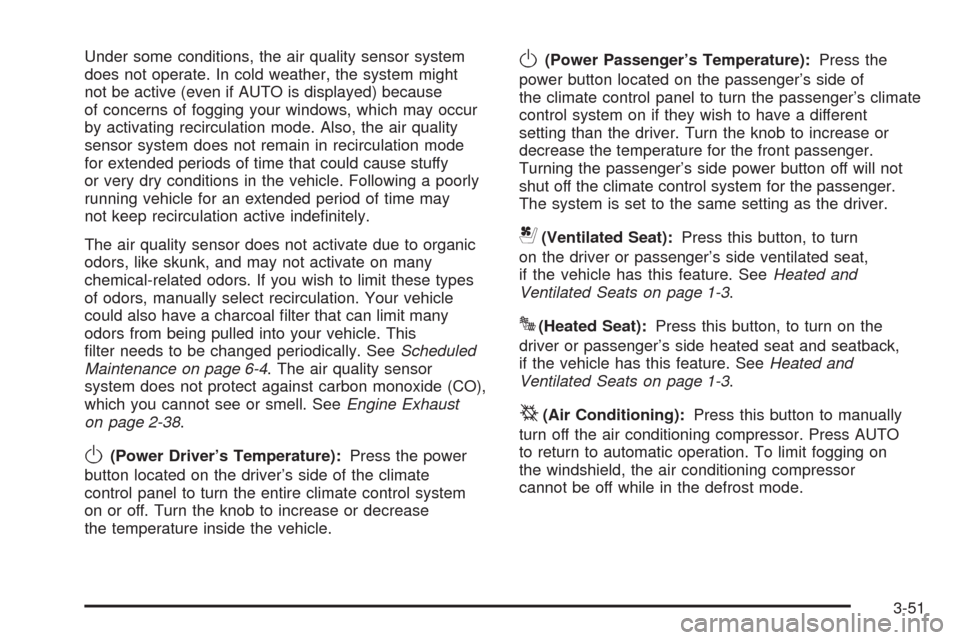
Under some conditions, the air quality sensor system
does not operate. In cold weather, the system might
not be active (even if AUTO is displayed) because
of concerns of fogging your windows, which may occur
by activating recirculation mode. Also, the air quality
sensor system does not remain in recirculation mode
for extended periods of time that could cause stuffy
or very dry conditions in the vehicle. Following a poorly
running vehicle for an extended period of time may
not keep recirculation active inde�nitely.
The air quality sensor does not activate due to organic
odors, like skunk, and may not activate on many
chemical-related odors. If you wish to limit these types
of odors, manually select recirculation. Your vehicle
could also have a charcoal �lter that can limit many
odors from being pulled into your vehicle. This
�lter needs to be changed periodically. SeeScheduled
Maintenance on page 6-4. The air quality sensor
system does not protect against carbon monoxide (CO),
which you cannot see or smell. SeeEngine Exhaust
on page 2-38.
O(Power Driver’s Temperature):Press the power
button located on the driver’s side of the climate
control panel to turn the entire climate control system
on or off. Turn the knob to increase or decrease
the temperature inside the vehicle.
O(Power Passenger’s Temperature):Press the
power button located on the passenger’s side of
the climate control panel to turn the passenger’s climate
control system on if they wish to have a different
setting than the driver. Turn the knob to increase or
decrease the temperature for the front passenger.
Turning the passenger’s side power button off will not
shut off the climate control system for the passenger.
The system is set to the same setting as the driver.
{(Ventilated Seat):Press this button, to turn
on the driver or passenger’s side ventilated seat,
if the vehicle has this feature. SeeHeated and
Ventilated Seats on page 1-3.
J(Heated Seat):Press this button, to turn on the
driver or passenger’s side heated seat and seatback,
if the vehicle has this feature. SeeHeated and
Ventilated Seats on page 1-3.
^(Air Conditioning):Press this button to manually
turn off the air conditioning compressor. Press AUTO
to return to automatic operation. To limit fogging on
the windshield, the air conditioning compressor
cannot be off while in the defrost mode.
3-51
Page 206 of 500
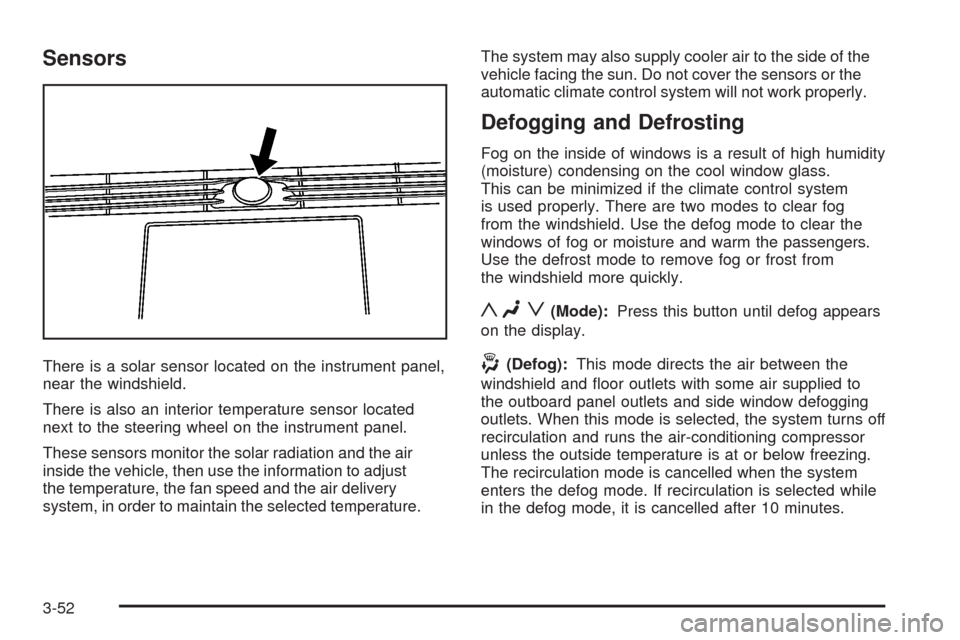
Sensors
There is a solar sensor located on the instrument panel,
near the windshield.
There is also an interior temperature sensor located
next to the steering wheel on the instrument panel.
These sensors monitor the solar radiation and the air
inside the vehicle, then use the information to adjust
the temperature, the fan speed and the air delivery
system, in order to maintain the selected temperature.The system may also supply cooler air to the side of the
vehicle facing the sun. Do not cover the sensors or the
automatic climate control system will not work properly.
Defogging and Defrosting
Fog on the inside of windows is a result of high humidity
(moisture) condensing on the cool window glass.
This can be minimized if the climate control system
is used properly. There are two modes to clear fog
from the windshield. Use the defog mode to clear the
windows of fog or moisture and warm the passengers.
Use the defrost mode to remove fog or frost from
the windshield more quickly.
yNz(Mode):Press this button until defog appears
on the display.
-(Defog):This mode directs the air between the
windshield and �oor outlets with some air supplied to
the outboard panel outlets and side window defogging
outlets. When this mode is selected, the system turns off
recirculation and runs the air-conditioning compressor
unless the outside temperature is at or below freezing.
The recirculation mode is cancelled when the system
enters the defog mode. If recirculation is selected while
in the defog mode, it is cancelled after 10 minutes.
3-52
Page 207 of 500
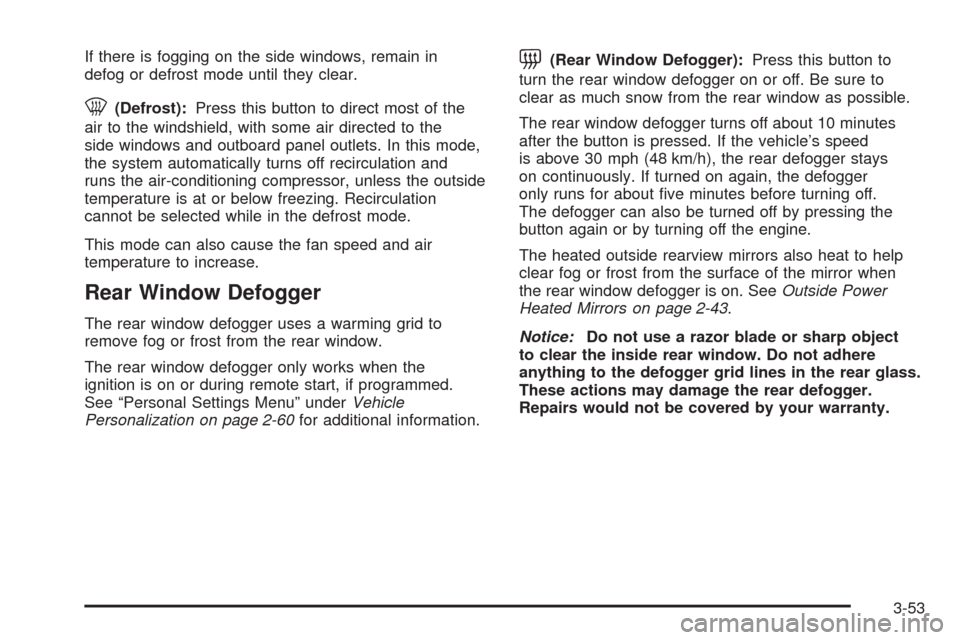
If there is fogging on the side windows, remain in
defog or defrost mode until they clear.
0(Defrost):Press this button to direct most of the
air to the windshield, with some air directed to the
side windows and outboard panel outlets. In this mode,
the system automatically turns off recirculation and
runs the air-conditioning compressor, unless the outside
temperature is at or below freezing. Recirculation
cannot be selected while in the defrost mode.
This mode can also cause the fan speed and air
temperature to increase.
Rear Window Defogger
The rear window defogger uses a warming grid to
remove fog or frost from the rear window.
The rear window defogger only works when the
ignition is on or during remote start, if programmed.
See “Personal Settings Menu” underVehicle
Personalization on page 2-60for additional information.
=(Rear Window Defogger):Press this button to
turn the rear window defogger on or off. Be sure to
clear as much snow from the rear window as possible.
The rear window defogger turns off about 10 minutes
after the button is pressed. If the vehicle’s speed
is above 30 mph (48 km/h), the rear defogger stays
on continuously. If turned on again, the defogger
only runs for about �ve minutes before turning off.
The defogger can also be turned off by pressing the
button again or by turning off the engine.
The heated outside rearview mirrors also heat to help
clear fog or frost from the surface of the mirror when
the rear window defogger is on. SeeOutside Power
Heated Mirrors on page 2-43.
Notice:Do not use a razor blade or sharp object
to clear the inside rear window. Do not adhere
anything to the defogger grid lines in the rear glass.
These actions may damage the rear defogger.
Repairs would not be covered by your warranty.
3-53
Page 208 of 500
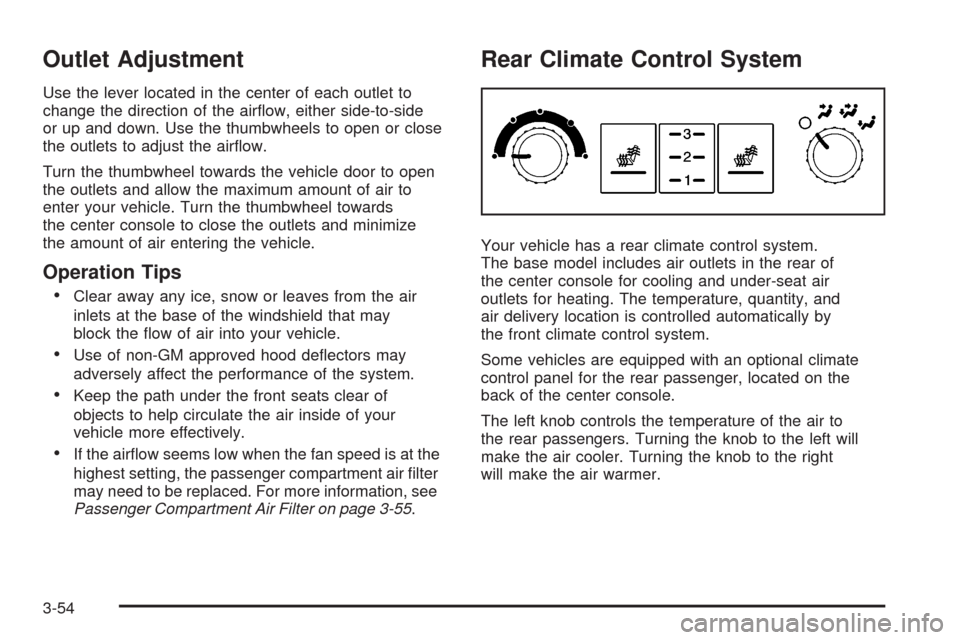
Outlet Adjustment
Use the lever located in the center of each outlet to
change the direction of the air�ow, either side-to-side
or up and down. Use the thumbwheels to open or close
the outlets to adjust the air�ow.
Turn the thumbwheel towards the vehicle door to open
the outlets and allow the maximum amount of air to
enter your vehicle. Turn the thumbwheel towards
the center console to close the outlets and minimize
the amount of air entering the vehicle.
Operation Tips
Clear away any ice, snow or leaves from the air
inlets at the base of the windshield that may
block the �ow of air into your vehicle.
Use of non-GM approved hood de�ectors may
adversely affect the performance of the system.
Keep the path under the front seats clear of
objects to help circulate the air inside of your
vehicle more effectively.
If the air�ow seems low when the fan speed is at the
highest setting, the passenger compartment air �lter
may need to be replaced. For more information, see
Passenger Compartment Air Filter on page 3-55.
Rear Climate Control System
Your vehicle has a rear climate control system.
The base model includes air outlets in the rear of
the center console for cooling and under-seat air
outlets for heating. The temperature, quantity, and
air delivery location is controlled automatically by
the front climate control system.
Some vehicles are equipped with an optional climate
control panel for the rear passenger, located on the
back of the center console.
The left knob controls the temperature of the air to
the rear passengers. Turning the knob to the left will
make the air cooler. Turning the knob to the right
will make the air warmer.
3-54
Page 209 of 500
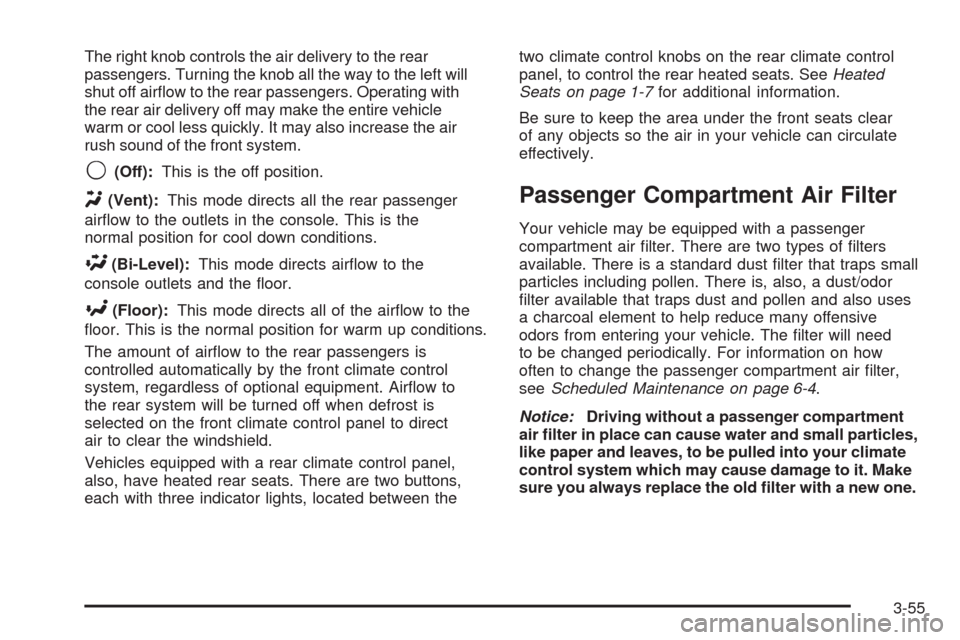
The right knob controls the air delivery to the rear
passengers. Turning the knob all the way to the left will
shut off air�ow to the rear passengers. Operating with
the rear air delivery off may make the entire vehicle
warm or cool less quickly. It may also increase the air
rush sound of the front system.
9(Off):This is the off position.
Y(Vent):This mode directs all the rear passenger
air�ow to the outlets in the console. This is the
normal position for cool down conditions.
\(Bi-Level):This mode directs air�ow to the
console outlets and the �oor.
[(Floor):This mode directs all of the air�ow to the
�oor. This is the normal position for warm up conditions.
The amount of air�ow to the rear passengers is
controlled automatically by the front climate control
system, regardless of optional equipment. Air�ow to
the rear system will be turned off when defrost is
selected on the front climate control panel to direct
air to clear the windshield.
Vehicles equipped with a rear climate control panel,
also, have heated rear seats. There are two buttons,
each with three indicator lights, located between thetwo climate control knobs on the rear climate control
panel, to control the rear heated seats. SeeHeated
Seats on page 1-7for additional information.
Be sure to keep the area under the front seats clear
of any objects so the air in your vehicle can circulate
effectively.
Passenger Compartment Air Filter
Your vehicle may be equipped with a passenger
compartment air �lter. There are two types of �lters
available. There is a standard dust �lter that traps small
particles including pollen. There is, also, a dust/odor
�lter available that traps dust and pollen and also uses
a charcoal element to help reduce many offensive
odors from entering your vehicle. The �lter will need
to be changed periodically. For information on how
often to change the passenger compartment air �lter,
seeScheduled Maintenance on page 6-4.
Notice:Driving without a passenger compartment
air �lter in place can cause water and small particles,
like paper and leaves, to be pulled into your climate
control system which may cause damage to it. Make
sure you always replace the old �lter with a new one.
3-55
Page 210 of 500
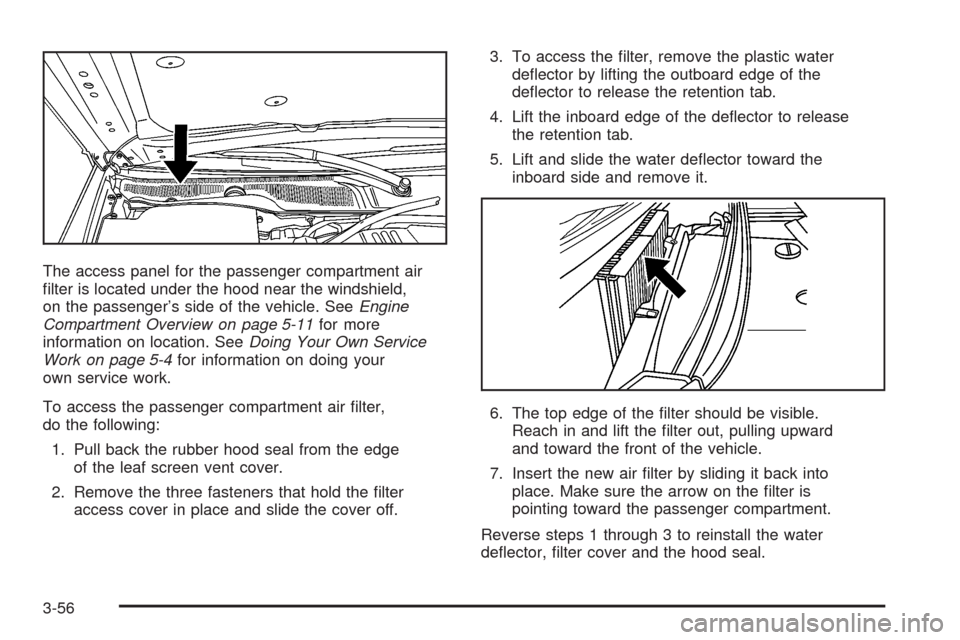
The access panel for the passenger compartment air
�lter is located under the hood near the windshield,
on the passenger’s side of the vehicle. SeeEngine
Compartment Overview on page 5-11for more
information on location. SeeDoing Your Own Service
Work on page 5-4for information on doing your
own service work.
To access the passenger compartment air �lter,
do the following:
1. Pull back the rubber hood seal from the edge
of the leaf screen vent cover.
2. Remove the three fasteners that hold the �lter
access cover in place and slide the cover off.3. To access the �lter, remove the plastic water
de�ector by lifting the outboard edge of the
de�ector to release the retention tab.
4. Lift the inboard edge of the de�ector to release
the retention tab.
5. Lift and slide the water de�ector toward the
inboard side and remove it.
6. The top edge of the �lter should be visible.
Reach in and lift the �lter out, pulling upward
and toward the front of the vehicle.
7. Insert the new air �lter by sliding it back into
place. Make sure the arrow on the �lter is
pointing toward the passenger compartment.
Reverse steps 1 through 3 to reinstall the water
de�ector, �lter cover and the hood seal.
3-56